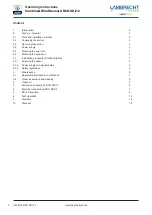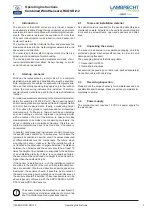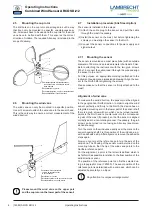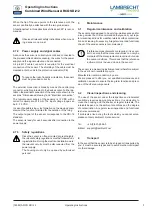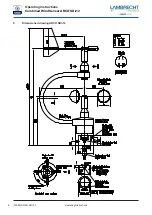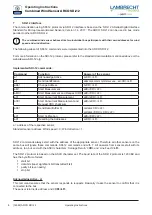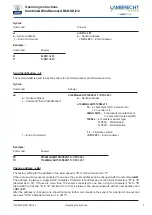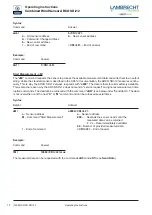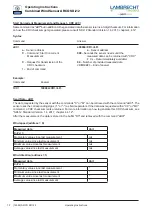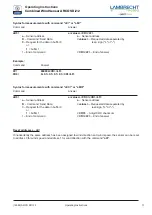
Operating Instructions
Combined Wind Sensor ARCO SDI-12
(14582) ARCO SDI-12
Operating Instructions
2.1
Tools and installation material
No special tools are required for the pending assembly and
maintenance work. All work can be carried out with standard
tools such as screwdrivers, open-end spanners and Allen
keys.
2.2
Unpacking the sensor
The sensor is delivered in a separate packaging, carefully
protected against mechanical influences, in order to avoid
damage during transport.
The packaging includes the following items:
· 1 Sensor ARCO SDI-12
· 1 Operating Instructions
Accessories: (depending on order scope, packed separately)
Connection cable with cable plug
2.3
Receiving inspection
Please check the scope of delivery for completeness and any
possible transport damage. Please report any complaints im-
mediately in writing.
2.4
Power supply
The compact sensor requires 12 VDC as power supply for
the electronics.
1 Introduction
The sensors of the ARCO series are very robust, compact
and extremely reliable. During their development, special care
was taken to ensure compliance with meteorological require-
ments. The sensors represent the experience of more than
150 years of development and production of wind sensors at
Lambrecht meteo.
The system records the horizontal air flow and processes the
measured values into the meteorological parameters wind
speed and wind direction.
The sensors and other system components are mounted in a
splash-proof and dustproof metal housing.
The housing and the measuring elements are made of cor-
rosion-resistant aluminium alloys. Sensor housing, cup rotor
and wind vane are anodized.
2
Start-up · General
Wind can be represented by a vector size. For a complete
description, wind speed and wind direction must be specified.
Both components are subject to spatial and temporal varia-
tions, so that strictly speaking they apply only to the location
where the measuring instrument is installed. Therefore,
special attention should be paid to the choice of installation
location.
For wind measurements according to the meteorological stan-
dards (for example VDI 3786, Part 2), the measuring height
and measuring location are decisive criteria for representative
and error-free measurements. Ideally, a measuring height
of 10 m above the ground is recommended for professional
measurements. Furthermore, there should be no obstacles
such as buildings, vehicles, airplanes or anything similar
within a radius of 150 m of the station. In cases of mobile
measurements on vehicles or on measuring containers, the
above conditions are not always achievable. Therefore, ac-
ceptable compromises have to be found and, if necessary,
documented.
In general, wind measuring instruments should not measure
the specific wind conditions of a limited area, but indicate the
typical wind conditions in a wider area. The values measured
at different places must be comparable. Therefore, when
mounting the sensor, make sure that the installation site is
not located in the slipstream of larger obstacles. The distance
between the obstacles and the sensor should be at least 10
times the height of the obstacles (corresponds to the definition
of an undisturbed terrain). If there is no undisturbed terrain,
the sensor must be positioned at a height that is at least 5 m
higher than the obstacle height.
If the sensor is installed on a roof, the installation location
should be in the middle of the roof so that preferential direc-
tions are avoided. If both wind direction and wind speed are
measured, the sensors should, if possible, be mounted at
the same measuring point, whereby any mutual influence of
the sensors should be avoided. These requirements can be
advantageously achieved with the ARCO-SERIAL, ARCO
SDI-12 and ARCO-NAV sensors.
The sensor must not be mounted on or near transmit-
ters or antennas. A minimum distance of 2 m must be
kept for interference-free signal transmission.
3


